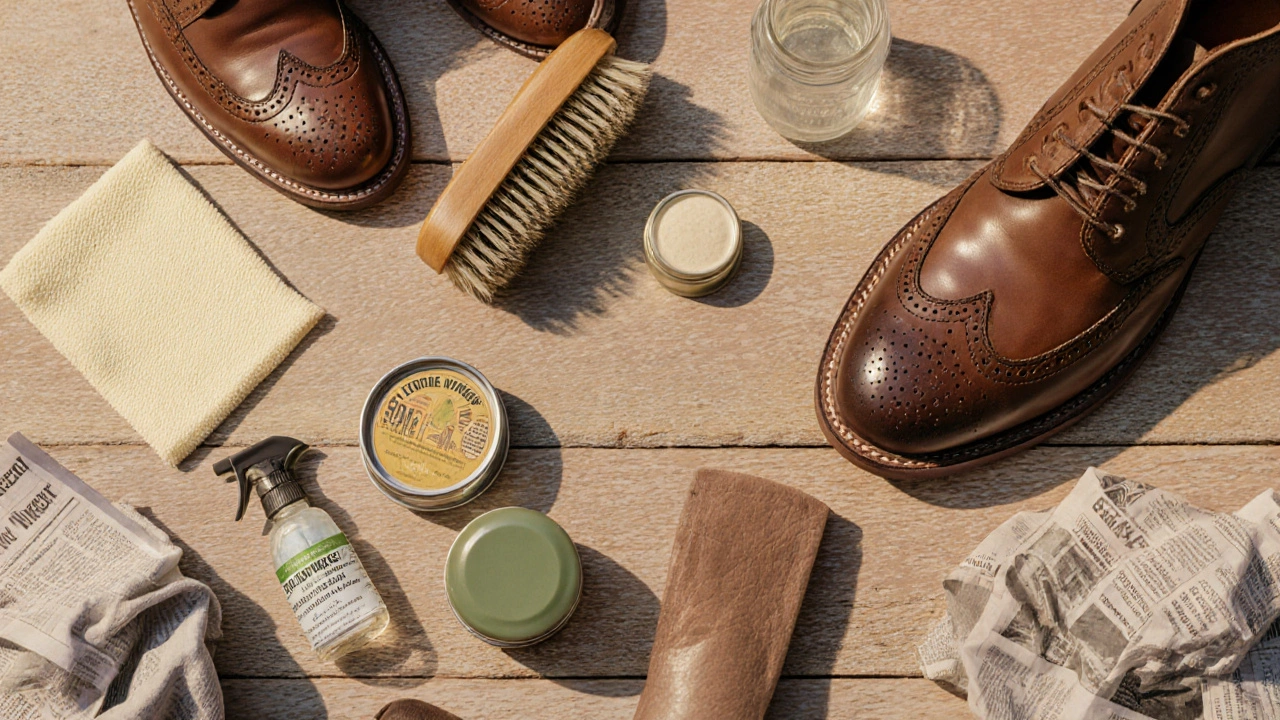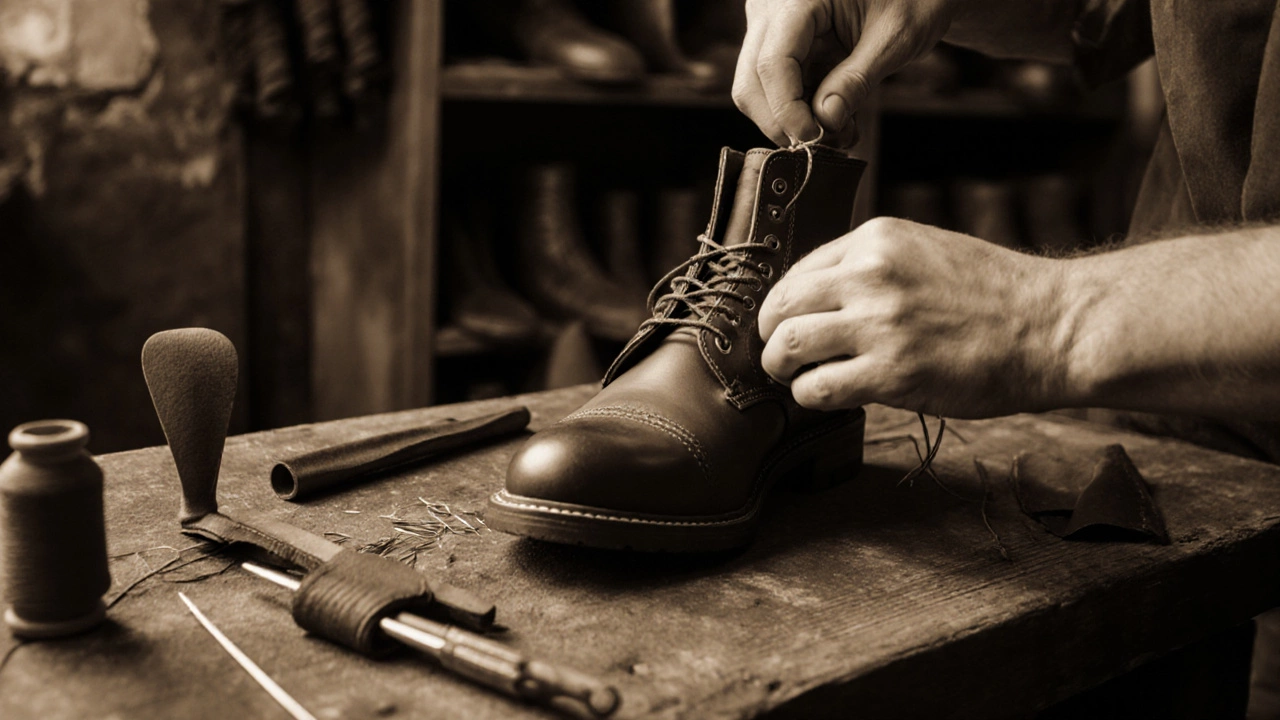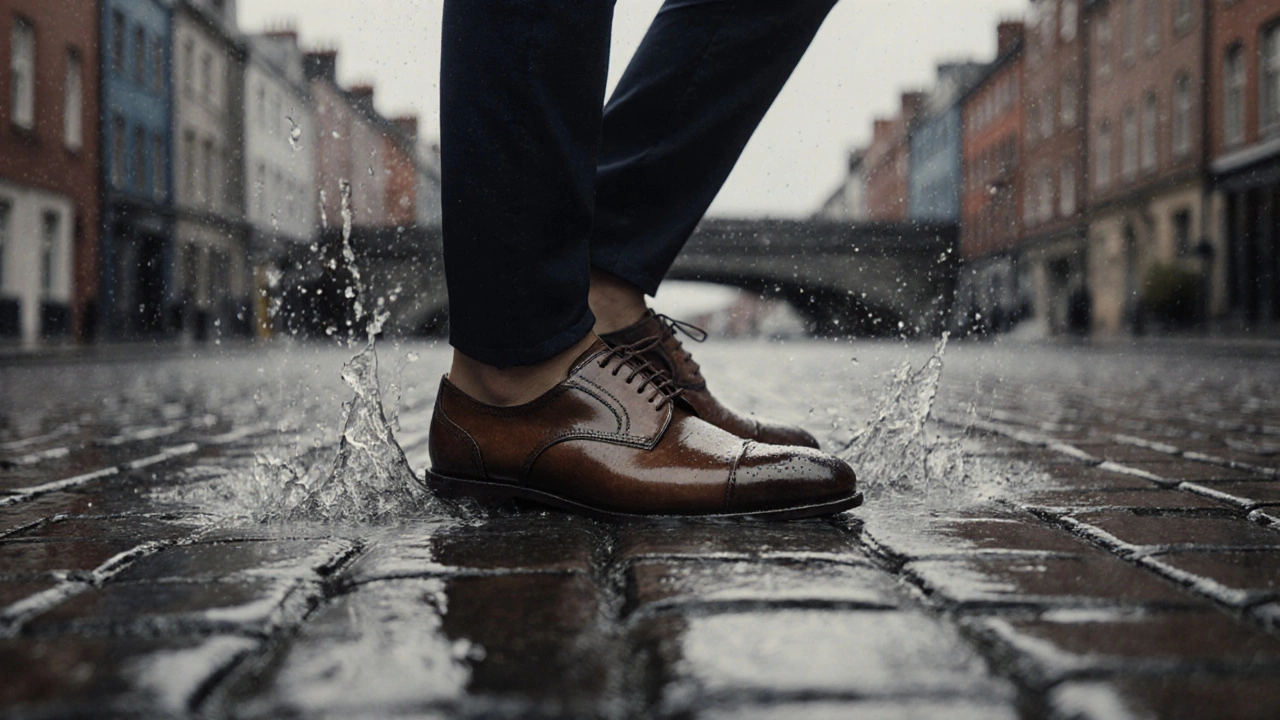Leather Shoe Damage Checker
Answer the following questions to identify potential threats to your leather shoes in Irish conditions.
Your Risk Assessment
Water Damage
Rain, puddles, and moisture can cause swelling, stiffness, and colour loss.
Salt Damage
Road salt causes corrosion and white residue on leather surfaces.
Heat Damage
Direct heat makes leather brittle and prone to cracking.
Chemical Damage
Harsh cleaners and incorrect polishes strip oils and cause discolouration.
Quick Takeaways
- Irish weather, especially rain and road salt, is the biggest threat to leather shoes.
- Quick‑dry wipes, regular conditioning, and proper storage stop most damage before it starts.
- Heat, harsh chemicals, and improper polishing can permanently alter the leather grain.
- Invest in a quality waterproof spray and a local cobbler for deep repairs.
- Follow a simple weekly routine and your shoes will stay sharp for years, even on wet Dublin streets.
Living in Ireland means you love a good walk along the Liffey or a night out in Temple Bar, but the same weather that makes the scenery lush can also be ruthless on leather shoes is a type of footwear made from animal hide that provides flexibility, breathability, and a classic look. From polished brogues for a Dublin office meeting to rugged leather boots for a hike in the Wicklow Mountains, knowing how to keep them in top shape is essential. This guide shows you exactly what can ruin leather shoes, how to spot early signs of damage, and the Irish‑specific steps you can take to protect them.
What Actually Ruins Leather Shoes?
Leather is a natural material, so it reacts to its environment. Below are the most common culprits you’ll encounter in Ireland.
- Water-Rain, puddles, and splashes are inevitable on Irish streets. When water seeps into the leather, it swells the fibers, leading to stiffness, cracks, and loss of colour.
- Salt-Road de‑icing salt used during winter months. Salt draws moisture out of the leather and accelerates corrosion, especially on the soles and stitching.
- Heat-Direct sunlight, radiators, or hair‑dryers. Excess heat dries out the leather, making it brittle and prone to cracks.
- Harsh chemicals-Cleaning agents, shoe sprays not designed for leather, or even strong shoe polish. These can strip natural oils and discolor the leather.
- Improper polishing-Using a rough cloth or excessive polish. Over‑polishing builds up a sticky layer that attracts dirt and can cause the leather to warp.
How to Spot Early Damage
Catch issues before they become permanent. Here’s what to look for after a day walking through damp Dublin lanes:
- Dark spots that don’t dry quickly - a sign water has penetrated the surface.
- White, chalky residue on the toe - usually salt crystallising.
- Loss of suppleness when you bend the shoe - indicates drying out from heat or lack of conditioning.
- Streaky or uneven colour after polishing - often caused by using the wrong polish type.
- Cracks along the seam or on the heel - the most visible sign of severe dehydration.

Weekly Care Routine for Irish Conditions
Stick to this simple schedule and you’ll keep most damage at bay, even during a sudden storm on the Wild Atlantic Way.
- Step 1 - Brush off dirt. Use a soft horsehair brush (available at Brown Thomas or local shoe stores) to remove mud and grit before it rubs into the leather.
- Step 2 - Spot‑clean wet areas. Dab (don’t rub) with a clean, slightly damp cloth. For stubborn salt, mix one part white vinegar with two parts water, apply lightly, then wipe clean.
- Step 3 - Condition. Apply a pea‑sized amount of leather conditioner-a cream that restores natural oils, such as Sofolk or a locally produced Irish brand, using a soft cloth. Let it absorb for 10‑15 minutes.
- Step 4 - Polish (optional). If you need shine, use a matching shoe polish-wax or cream formulated for leather. Apply thinly, buff with a clean brush, and avoid over‑coating.
- Step 5 - Waterproof. Finish with a light spray of waterproof spray-a silicone‑based protector that repels rain without darkening the leather. Brands like Nikwax or Gola work well in Irish weather.
Emergency Fixes When You’re Caught Out
Sometimes you’ll be stuck in a downpour on O’Connell Street with no time for a full routine. Here’s what to do on the spot.
- Dry quickly. Pat the shoes with a dry microfiber towel, then stuff them with newspaper to absorb moisture. Change the paper every 30 minutes.
- Neutralise salt. Sprinkle a tiny amount of baking soda on the affected area, let sit for 15 minutes, then brush off.
- Heat caution. Never place shoes near a radiator. If you need to speed drying, use a cool fan on low.
- Temporary protection. Wrap the shoes in a breathable cloth (like a cotton scarf) until you can apply a proper waterproof spray at home.
When to Call a Professional Cobbler
Even with the best care, some damage needs a skilled hand. Irish cobblers such as O'Neill's Shoe Repair-a Dublin‑based cobbler known for restoring high‑end leather footwear or the family‑run shop in Galway's Latin Quarter can:
- Re‑soling worn out treads after walking the cobbled streets of Kilkenny.
- Stitching cracks that have split the leather from repeated rain exposure.
- Deep cleaning and re‑finishing of antique brogues for a wedding in the Irish countryside.
Most cobblers charge a modest fee for a basic restore-often less than the cost of a new pair, and the result looks as good as new.

Comparison Table: Common Damage Sources vs. Prevention
| Threat | Typical Damage | Prevention Method |
|---|---|---|
| Water (rain, puddles) | Swelling, colour bleed, stiffness | Quick‑dry wipes, waterproof spray, immediate drying |
| Salt (road de‑icing) | White deposits, corrosion of stitching | Vinegar‑water cleaning, regular conditioning |
| Heat (radiators, sun) | Brittle leather, cracks | Avoid direct heat, store in cool shoe bag |
| Harsh chemicals | Discolouration, loss of oil | Use leather‑specific products only |
| Improper polishing | Sticky surface, uneven shine | Apply thin layers, buff with soft cloth |
Tips From Irish Shoe Lovers
We asked a few Dublin commuters and Galway hikers about their favorite tricks. Here’s what they shared:
- "I keep a small bottle of leather conditioner in my briefcase. A quick rub after a rainy commute keeps my Oxfords looking sharp," says Siobhan, a solicitor in the Docklands.
- "My brother swears by a simple dust‑off with a dry tea towel before putting boots away for the winter. It stops the mud from digging into the leather," notes Conor, a mountain guide in the Burren.
- "For my suede trainers, I use a suede brush after every rainy weekend. It restores the nap and stops water spots," adds Niamh, a student at UCD.
Bottom Line: Can You Ruin Leather Shoes?
Yes-Irish weather, mis‑use, and neglect can all cause irreversible damage. But with the right routine, a few quality products, and occasional professional help, you can extend the life of your leather shoes by years. Treat them as an investment, not a disposable item, and they’ll keep you looking polished whether you’re heading to a Dublin pub or trekking the cliffs of Moher.
Frequently Asked Questions
Will water damage my leather shoes if I don’t dry them immediately?
Yes. Water can seep into the pores, causing the leather to swell and lose its natural oils. The longer it stays wet, the higher the risk of stain and stiffness. Use a towel and newspaper to dry quickly, then condition.
Is it safe to use a regular household spray bottle on my shoes?
Only if the spray is labelled for leather. Household disinfectants contain alcohol or bleach, which strip oils and cause discoloration. Stick to leather‑specific waterproof sprays.
How often should I condition my leather shoes?
At least once a month in dry months, and twice a month during the wet winter season. If you notice the leather feeling dry when you bend it, apply conditioner immediately.
Can I fix cracked leather myself?
Minor cracks can be softened with a leather cream and gentle massage. Deep cracks that split the grain need a professional cobbler to stitch or patch the area.
What’s the best way to store leather shoes during the off‑season?
Place them in a breathable shoe bag, insert cedar shoe trees to maintain shape, and keep them in a cool, dry closet. Avoid plastic bags, which trap moisture.
